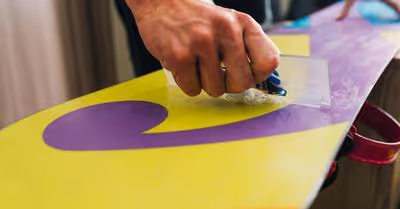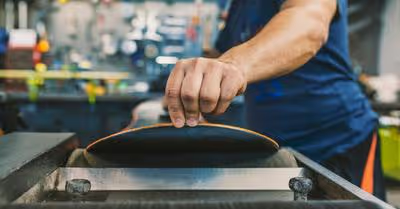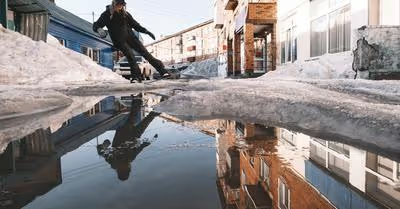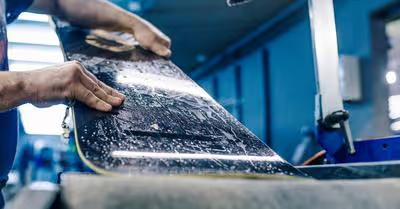Table of Contents
What Is Snowboard Wax Made Of?
Snowboard wax is made of a mixture of polymers, oils, and chains. These polymers help give the snowboard a snow-like feeling and make it easier to glide on the snow. The chains are made up of special metals that help give grip and friction while gliding.
The wax is made up of polymers because they have amazing properties when it comes to reducing friction, smoother gliding, and easier grip. The oils are used to create a wet surface that gives the snowboarder a better grip on their board.
It can be applied to the entire board of a snowboard, and it's designed to collect and hold the snow. This method is a way to renew the feeling of your board and give it a new finish for more accuracy when riding.
Snowboard wax happens to be made up of many different ingredients, but most commonly includes petroleum-based waxes which work as a protective layer. Waxes also contain plasticizers or other common chemicals.
The only other materials that are used in production are water, dyes, and pigments.
Snowboard wax is a product made of natural and synthetic materials that is used to reduce friction between the snowboard and the snow.
It comes in different types, depending on how it is made. The most common type of snowboard wax contains urethane, which is a polymer that makes up at least 20% of its total mass. Some formulations include different materials too.
The type of snowboard wax you use can depend on your preferences as well as your riding style. Some people prefer a softer board to ride on while others enjoy going faster and prefer using wax with a harder composition for better traction and glide.
How Does Snowboard Wax Work?
Snowboard wax is a material that you put on top of your board to increase friction and grip while riding. So what makes it work? Three key components go into snowboard waxes.
The base coat is made up of polymers and oils to help the wax stick to the snowboard. This base is where you get the initial benefits from the wax while applying it to your board.
Next is the topcoat that is also made up of natural and synthetic polymers. This helps give the wax a shiny finish and the slippery feel it adds to the exterior of your board.
Lastly, you will see resin included too. This is a polymer that is applied as an intermediate layer between the bottom layer and the top layer, adding strength and durability.
Snowboard waxes are used for grip and control on snowboards. The wax sticks to the board and increases friction or the interaction between the snowboard and the snow. This also helps prevent the board from becoming too slippery when wet and cold temperatures are involved.
The base layer is applied first, followed by the top layer, which is applied last. The hard shell is then applied to protect against abrasion due to friction with other objects on the mountain.
When you first start snowboarding, you might not be sure how to use your snowboard wax. But, once you start using it, you’ll quickly figure out what wax is best for the type of terrain and weather conditions that you are in.
What Are The Different Types Of Snowboard Wax?
Snowboard wax can be broadly classified into a few different types based on the primary materials included. These different types all have their pros and cons, and you should shop carefully for your snowboard wax.
Hydrocarbon Wax
Hydrocarbon snowboard wax is a type of snowboard wax that is made up of many different hydrocarbons. This is the most basic type of snowboard wax and it has ingredients like paraffin and other synthetics.
This type of wax is a substance that is applied to the base of a snowboard to provide some traction, reduce friction, and increase glide. The friction on your board can be lowered by using hydrocarbon wax.
It will lower the level of friction on your board for smooth riding. It has a unique formula that provides high-performance and great glide for all types of riders. It also lasts longer than other types of waxes, making it an excellent choice for most people who use it regularly.
Fluorocarbon Wax
Fluorocarbon wax is a type of wax that is used on snowboards to improve the glide of your board when it is wet outside. It comes in a variety of finishes and can be applied to the snowboard quickly.
It is made from polymers that are created by combining fluorine, carbon, and hydrogen. It was first used as an anti-fogging agent for airplane windows but has since been found to be useful in many other applications.
This wax bonds with the base layer of the snowboard. It makes it easier for riders to slide along the slope and improves their ability to grip on icy surfaces.
Graphite (Molybdenum) Wax
Graphite wax uses molybdenum and carbon to create a reliable compound that works on snowboards. It is typically used as a coating on the bottom of a snowboard to improve its glide.
The material has been around for many years but became popular in recent years due to its high performance and low cost. It is known to repel things like dirt from your board to maintain a cleaner finish too.
The most important thing that graphite wax can provide is speed. It is a desirable product for more expert riders that want to ride as fast as possible, knowing they will have maximum board control.
Is Snowboard Wax Considered Toxic?
Snowboard wax is a commonly found substance that is used to make boards more slippery or easier to ride on. But, it can be dangerous if it is inhaled in large amounts.
Snowboard wax can become dangerous because it becomes very slippery when inhaled while being exposed to enzymes from the nose and lungs. This causes suffocation due to an inability of the body to get enough oxygen, which can cause death by asphyxiation.
Wax is a very important part of snowboarders' equipment. It is used to make the top layer of the board stick to the base layer of wax. It also helps snowboarders glide with ease on the snow, prevents scratches and rusts, and improves comfort levels.
Wax is known to contain chemicals and may cause skin irritations and burns. It is considered toxic because it contains both PFAs and PFCs. Exposure to these chemicals in excess amounts can lead to severe health concerns.
It is best to proceed with caution when you are handling snowboard wax. This wax is also known to be harmful to the environment.
Recent Articles
















